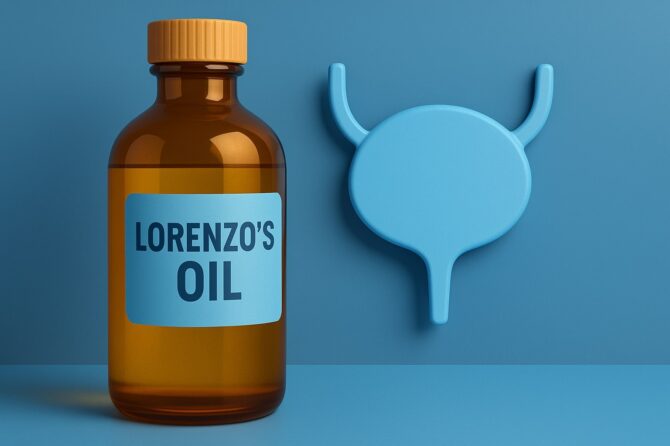
Lorenzo’s Oil and Prostate Health: A Review of Its Therapeutic Potential
Abstract
Lorenzo’s Oil, a unique blend of oleic acid and erucic acid, gained fame in the early 1990s as a therapeutic dietary intervention for X-linked adrenoleukodystrophy (ALD). While its primary research and application lie in neurological and genetic disorders, emerging interest has turned toward its systemic effects, particularly regarding inflammation, cellular regulation, and hormone modulation, which may indirectly benefit prostate health. This article explores the biochemical profile of Lorenzo’s Oil, evaluates its relevance to prostate and urinary function, examines its ingestion methods, and provides available data linking its components to men’s urological health.
1. Introduction
Lorenzo’s Oil is a 50:50 mixture of glycerol trioleate (GO) and glycerol trierucate (GE)—triglyceride forms of oleic acid (an omega-9 fatty acid) and erucic acid (a monounsaturated omega-9 fatty acid), respectively. It was formulated in an effort to reduce the accumulation of very long-chain fatty acids (VLCFAs) in the brain and adrenal tissues of individuals suffering from ALD. However, as biochemical interest grows in the anti-inflammatory, lipid-modulating, and peroxisome-targeting properties of these fatty acids, they have garnered attention for potential systemic benefits, including in the prostate.
2. Composition and Biochemical Mechanisms
2.1 Oleic Acid (C18:1)
Oleic acid is a monounsaturated omega-9 fatty acid commonly found in olive oil. It has been associated with:
- Anti-inflammatory effects via NF-κB pathway inhibition.
- Improved lipid profiles, which may reduce metabolic stress linked to prostatic inflammation.
- Modulation of hormonal activity, including androgen and estrogen receptors.
2.2 Erucic Acid (C22:1)
Erucic acid is less prevalent in the typical Western diet but plays a crucial role in:
- Peroxisomal β-oxidation enhancement, potentially beneficial in cellular detoxification processes.
- Reducing oxidative stress, a contributing factor in benign prostatic hyperplasia (BPH) and prostate cancerdevelopment.
- Suppression of pro-inflammatory cytokines, possibly limiting chronic prostatitis.
2.3 VLCFA Reduction and Systemic Implications
By lowering VLCFA accumulation, Lorenzo’s Oil may reduce systemic inflammation, which is often implicated in the pathogenesis of BPH, chronic pelvic pain syndrome, and prostate carcinogenesis.
3. Effects on Prostate Health
While no large-scale clinical trials have directly evaluated Lorenzo’s Oil for prostate health, the individual components provide theoretical and preliminary evidence for benefit:
3.1 Anti-Inflammatory Action
Chronic inflammation is a key component in the development of BPH and prostate cancer. Both erucic and oleic acids have demonstrated:
- Inhibition of COX-2 expression.
- Reduction in interleukin-6 (IL-6) and tumor necrosis factor-alpha (TNF-α).
- Modulation of NF-κB, a transcription factor involved in prostatic hyperplasia.
3.2 Hormonal Balance
Oleic acid may impact androgen metabolism, indirectly influencing DHT (dihydrotestosterone) levels—a primary driver of prostate enlargement.
3.3 Cancer-Preventive Properties
Studies have shown oleic acid can reduce the expression of oncogenes such as HER2, and erucic acid may inhibit proliferation of prostate cancer cells in vitro, though human data remains limited.
4. Urinary Benefits and LUTS (Lower Urinary Tract Symptoms)
Although Lorenzo’s Oil has not been studied for LUTS directly, the inflammatory suppression and hormonal modulation pathways affected by its fatty acids are relevant to urinary function:
- Reduced prostate swelling may lead to less bladder outlet obstruction.
- Improved smooth muscle tone and relaxed detrusor function due to anti-inflammatory effects may ease symptoms like urgency, frequency, and nocturia.
- Indirect effects may also benefit patients with chronic prostatitis/chronic pelvic pain syndrome (CP/CPPS) by modulating the neuroimmune axis.
5. Ingestion Methods
5.1 Dosage
Clinical use in ALD patients has included doses ranging from 2 to 4 tablespoons daily, but this is not an established or recommended dose for prostate health.
5.2 Administration
- Oral ingestion is standard, often taken with meals to enhance lipid absorption.
- Encapsulation may be possible for more palatable delivery.
- Use should be monitored by a healthcare provider due to the potential hepatotoxicity of high erucic acid intake.
5.3 Dietary Synergies
Combining Lorenzo’s Oil with:
- Antioxidant-rich foods (e.g., berries, cruciferous vegetables),
- Omega-3 fatty acids (to balance lipid profiles),
- And zinc and selenium supplementation (important for prostate function) may enhance therapeutic outcomes.
6. Safety Considerations and Contraindications
- Erucic acid in high concentrations has raised concerns due to cardiac lipid accumulation (myocardial lipidosis)in animal studies, but these effects have not been definitively observed in humans at medically supervised doses.
- Individuals with hepatic dysfunction or lipid metabolism disorders should avoid unsupervised use.
- Long-term safety data for Lorenzo’s Oil in healthy individuals or in those with prostate conditions is lacking.
7. Miscellaneous Data and Experimental Research
7.1 Neuroprotective and Mitochondrial Effects
Oleic acid and erucic acid have shown promise in:
- Enhancing mitochondrial function,
- Promoting neuronal resilience, and
- Modulating the gut-brain axis, which may indirectly impact neurogenic bladder components in urological health.
7.2 Experimental Cancer Models
Some studies using prostate cancer cell lines indicate that erucic acid may:
- Inhibit proliferation,
- Induce apoptosis,
- And modulate lipid metabolism pathways involved in tumor progression.
8. Conclusion
Although not originally formulated for prostate health, Lorenzo’s Oil—through its core constituents—shows potential in modulating the biological mechanisms underlying prostate inflammation, benign hyperplasia, and possibly prostate cancer. Its ingestion must be approached cautiously, with medical supervision and individual risk-benefit assessment, especially considering erucic acid’s safety profile. Continued research is warranted to explore its clinical utility in urology.
Leave a reply

Leave a reply